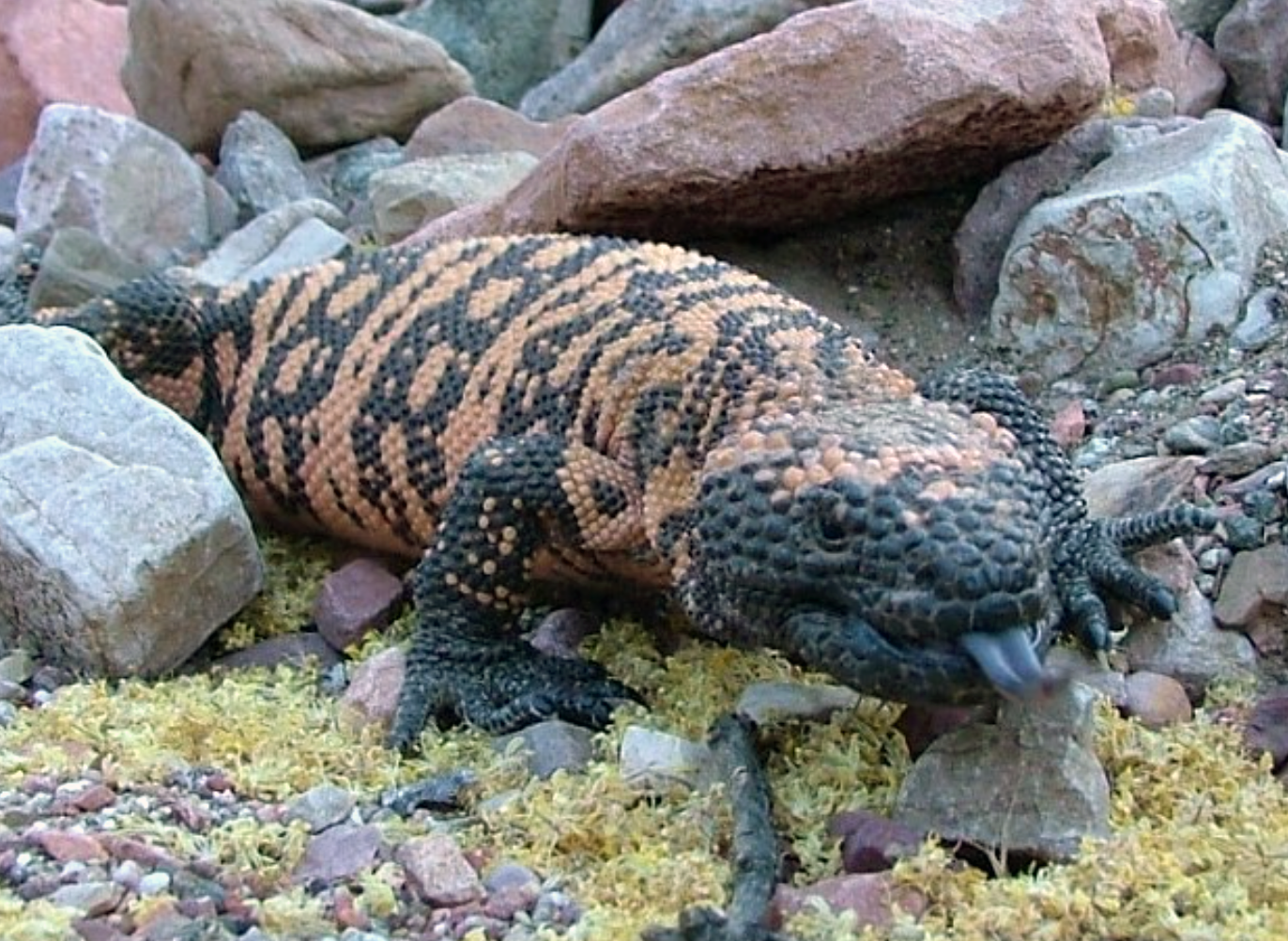
OverviewLike the saguaro cactus (Carnegia gigantea) and the rattlesnake, the Gila monster is representative of the desert Southwest. The Gila monster is not only the largest lizard native to the United States, but also one of only two known species of venomous lizards in the Americas. This stout-bodied lizard can grow to 50 cm (20 in) and is covered with black and pink or orange markings and bead-like scales. The Gila monster’s range is centered in western and southern Arizona, continuing south to Sonora, Mexico. Despite public fascination with the species, relatively little is known about the ecology and behavior of the Gila monster in the wild. For this reason, managers at Tonto National Monument, Arizona, contacted the U.S. Geological Survey (USGS) to investigate why Gila monsters were being seen in developed areas of the park, particularly crossing the main road. Managers were concerned about possible lizard-human conflicts and the risk of vehicle traffic killing Gila monsters. USGS scientists initiated a research effort in Tonto National Monument beginning in 2004 to provide information needed to make management decisions and improve scientific understanding of the species. Specifically, USGS scientists examined the movement patterns, range requirements, dietary habits, and use of developed areas by Gila monsters within the park. The 2004 research effort also extended a program begun in Tonto National Monument in 1994 to recognize individual Gila monsters based on unique dorsal patterns identified from photographs. Research FindingsThe research team searched for Gila monsters in Tonto National Monument during the spring and late-summer monsoon season in areas of the park that the animals were known to frequent. Gila monsters were captured when they were seen outside of these periods by park staff. Captured Gila monsters were weighed, measured, and photographed. Additionally, Gila monsters were injected with a small passive integrated microchip transponder (PIT tag), which carries a unique identification code that allows scientists to identify the animal each time it is encountered. Adult Gila monsters were surgically implanted with radio transmitters that allow scientists to track these lizards from a distance. In Tonto National Monument, Gila monsters were found to begin emerging from their hibernation sites starting in late March, with activity peaking in early April. As expected, the USGS scientists found a number of Gila monsters crossing the main road below the visitor center parking lot. USGS research findings indicated that although Gila monsters use the entire monument as their habitat, they seem to prefer rocky areas. Similar to the findings of other studies, the research team frequently found the radio-tracked animals underground. These shelter sites were typically burrows that the lizards dug under boulders and small rock outcrops. In terms of dietary habits, one of the Gila monsters captured by scientists regurgitated a freshly eaten clutch of unbroken Gambel's quail (Callipepla gambelii) eggs. Gila monsters also appear to be feeding in part on small mammals, including young desert cottontail (Sylvilagus audubonii). One of the radio-tracked Gila monsters was observed drinking from a leaking hose in the housing area. This observation is important because it shows the lizards are using human-modified habitats to meet basic ecological needs. Gila monsters exhibit a range of defensive behaviors when located by researchers. Of the 123 visual observations of radio-tracked animals, more than half (55%) of the Gila monsters moved under cover, ran away, or moved deeper into a burrow. In other cases, Gila monsters did not visibly react, froze before fleeing, or froze without moving when encountered by a scientist. These observations suggest that Gila monsters are not aggressive and prefer to avoid people. USGS scientists compared the recent photographs of dorsal patterns on individual Gila monsters with pictures taken in the mid-1990s. Photo comparisons allowed the researchers to document the recapture of at least three Gila monsters. These findings were significant because they confirm the potential effectiveness of using noninvasive photography as a long-term mark-recapture method for this species. Additionally, the method allowed scientists to confirm that one of the recaptured Gila monsters had lived in the wild for at least 12 years. Research ImplicationsThe USGS research provides some clues as to why Gila monsters frequent the main road and developed areas of Tonto National Monument. It is possible that the Gila monsters are moving across the road to reach preferred habitat in Cave Wash after emerging from their hibernation sites in nearby cliffs. Cave Wash is a site with relatively high humidity and Gila monsters have been documented to seek out moist sites during their active period. It is also possible that the lizards are following a traditional migration route. Additionally, the availability of water and food for prey species in the housing areas may explain the presence of Gila monsters in developed areas during their active period. Because the research confirmed the peak periods in which the Gila monsters are likely to be crossing the road, it provides park managers the opportunity to focus management actions on these periods. Periods when lizards are active also offer an opportunity to provide interpretive programs for park visitors, which may improve understanding of the animal and its needs. USGS research efforts in Tonto National Monument have increased scientific understanding of Gila monster ecology and behavior. Better understanding of the species can be used to improve management decisions and target limited resources in Arizona national parks. Knowing better how Gila monsters behave in the wild can also help people live in harmony with this colorful desert dweller. For More InformationUS Geological Survey Fact Sheet (April 2006) Nowak, E.M. 2005. Why did the Gila monster cross the road? Basic research at Tonto National Monument: 2004 annual report (04-15) and 2005 initial profess report (05-12) submitted to Western National Parks Association, US Geological Survey, Colorado Plateau Research Station. |
Last updated: June 22, 2022
